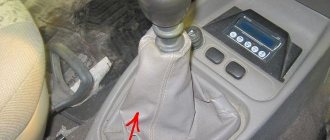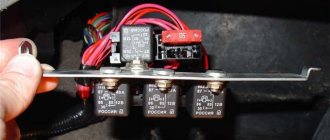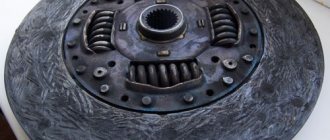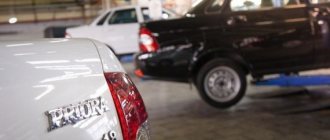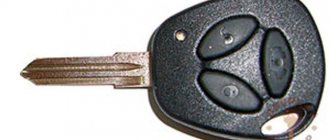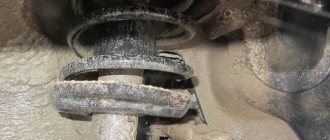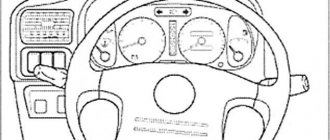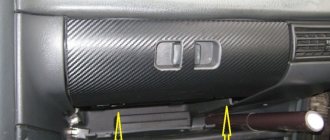Finding the cause of the problem
There are several reasons for a rattling shift lever. So that the motorist can understand which of them he has encountered, a simple disassembly of the mechanism will be required. First of all, you need to remove the gearbox cover (lift and pull), and then make several movements with the lever and try to determine where the rattling sound comes from.
If this does not help, then you can try knocking on the lever parts. A part that is poorly secured will make a corresponding sound. Sometimes poorly secured parts can be seen with the naked eye. If these tricks did not help, then all that remains is to remove the lever bolt and inspect the elements on it.
Removing and disassembling the gearbox control drive
We carry out the work on an inspection ditch or overpass. Below the car..
. Using a 13mm spanner, loosen the tightening of the nut of the coupling bolt of the clamp securing the control rod to the shank of the gear selector rod hinge.
Using a slotted screwdriver, we open the clamp and move it along the rod.
Remove the transmission control rod from the shaft of the gear selector rod hinge. Remove the clamp from the rod.
Using a 13mm spanner, unscrew the two bolts securing the torque rod to the base of the gear shift lever.
. and disconnect it from the base. In the cabin, remove the floor tunnel lining (see “Removing the floor tunnel lining”). Having unscrewed the fastening nuts, disconnect the air ducts for blowing the feet of rear seat passengers from the heater (see “Removing the instrument panel assembly with the heater”) and lift the air ducts. Squeezing the clamps of the wire block..
. disconnect it from the reverse gear lock solenoid switch block.
Use a 13mm socket to unscrew the three bolts securing the base of the gear shift lever, and unscrew the fourth bolt under the air duct with a 13mm wrench.
We remove the gear shift lever with its base, bringing the control rod into the cabin through a hole in the floor. Use an awl or a thin slotted screwdriver to pry it off.
. and remove the gear shift knob plug. Using a 13mm socket, unscrew the locknut securing the handle.
Unscrew and remove the handle from the lever. Turning the decorative cover inside out, loosen the plastic clamp securing the cover or cut the clamp.
Remove the cover from the lever. By loosening the plastic clamp securing the solenoid switch wires.
. remove the switch. If it is necessary to replace only the reverse gear lock solenoid switch, then these operations can be performed on the vehicle without removing the entire transmission control drive.
Using a 13mm spanner, unscrew the nut of the control rod axle bolt, holding the bolt axle from turning with a wrench of the same size. We take out the bolt-axle.
. and remove the metal washers, plastic bushings and spacer bushing.
Using circlip pliers, remove the circlip on the ball joint of the lever.
We remove the gear shift lever with the ball joint from the base. Removing the gear shift lever can be done on the vehicle without removing the entire drive assembly. To replace the upper rubber sealing ring (round section) of the ball joint, use a screwdriver to pry off the ring.
Remove the ball joint from the lever. Remove the lower sealing ring (rectangular section) from the ball joint.
Remove the transmission control rod from the case. The cover on the pull rod fits tightly. Therefore, to make removal easier, we moisten the rod with soapy water. If you only need to remove the drive rod.
. then using a 13mm spanner we loosen the tightening of the nut of the coupling bolt of the clamp securing the jet thrust to the tip. We unscrew the two bolts securing the torque rod to the base of the gear shift lever (see above).
Using a 13mm spanner, unscrew the nut securing the torque rod end to the gearbox bracket.
. and remove the jet rod assembly with the tip.
We remove two plastic bushings from the torque rod tip.
. and a rubber damper. Unclenching the clamp.
. remove the tip from the rod. We assemble and install the gearbox control drive in the reverse order. Before assembly, put LSC-15 lubricant into the ball joint of the lever. An assistant will be required to adjust the drive. Make sure that the switch rod in the gearbox is in the neutral position. Do not tighten the clamp bolt nut. We check the ease of axial movement and rotation of the box control rod relative to the shank of the switch rod hinge. In case of jamming, it is necessary to release the groove of the rod with a slotted screwdriver. We install the gear shift lever so that its lower part is perpendicular to the floor of the body, and the handle is located from the front passenger seat at a distance equal to 1/3 of the distance between the seats. Having installed the control rod clamp at a distance of 2-3 mm from the end of the rod, tighten the nut of the clamp coupling bolt. We check that the drive is adjusted correctly - nothing should interfere with the movement of the lever, the gears should engage easily and without jamming. Otherwise, repeat the adjustment.
Removing the gear shift mechanism drive may be necessary when replacing faulty parts (for example, to replace a torn drive rod boot, damaged drive rod). The sequence and number of operations indicated below can be changed depending on the purpose of the work.
To complete the work, you will need an assistant, as well as an inspection ditch or overpass.
Removal and disassembly
1. We prepare the car for work.
2. Clean the threads of the clamp bolt with a wire brush. We treat the junction of the rod with the hinge and the bolt with penetrating lubricant.
3. 13 mm wrench , loosen the tightening of the clamp bolt nut.
4. Unclench the clamp with a screwdriver and move it along the rod. Unclench the rod with a screwdriver.
5. After wiping the junction of the rod with the hinge with a rag, we mark the relative position of the drive rod and the hinge.
6. Disconnect the rod from the hinge.
7. Disconnect the torque rod from the base of the ball joint of the gear shift lever.
8. Inside the car, use a thin slotted screwdriver to remove the plug from the gear shift lever handle.
9. 13 mm socket wrench , unscrew the nut securing the handle bolt and remove the handle from the gear shift lever.
10. Using a screwdriver, we remove the cover from the floor tunnel lining and turn the cover inside out.
11. Disconnect the wiring harness from the reverse lock solenoid switch.
Loosen or cut the plastic clamp.
12. Remove the switch from the gear shift lever.
13. Remove the floor tunnel lining.
If necessary, you can unscrew the four bolts securing the gearshift lever support to the body (see below) and remove the drive assembly.
14. 13 mm wrench , unscrew the nut of the bolt securing the linkage to the lever, holding the bolt from turning with a second wrench of the same size.
15. Remove the bolt from the lever. We remove the lever from the traction fork. We remove the metal and plastic washers, take out the metal spacer sleeve.
16. To compress the drive rod, lubricate it with soapy water and remove it from the hole in the cover.
17. 13 mm socket , unscrew the three bolts securing the bracket to the body.
We unscrew the fourth bolt securing the bracket with a spanner of the same size (access to it from above is blocked by the air duct).
18. Remove the bracket and drive rod cover. We replace the torn cover.
19. We remove the gear shift lever support from the hole in the floor tunnel.
20. Use a puller to compress the locking ring of the ball joint of the lever and remove it from the base of the support.
21. Remove the lever from the base of the support.
22. Using a screwdriver, remove the top sealing ring.
23. Remove the support from the lever.
Assembly and installation
We assemble and install the drive in the reverse order. Before tightening the gearshift mechanism drive rod clamp, adjust the drive (see below).
Adjustment
1. We loosen the tightening of the drive rod clamp of the gear shift mechanism (see paragraphs 2-4 above).
2. We lift the lower part of the gear shift lever cover (see point 10 above).
3. We move the gear shift lever so that its lower part is perpendicular to the floor surface, and the lever handle is located from the right seat cushion at a distance approximately equal to 1/3 of the distance between the front seats and hold it in this position. In this case, the assistant, moving the clamp 2-3 mm from the end of the rod, tightens the clamp nut.
4. We install the cover in place and, by trying to engage the gears, make sure that the gear shift mechanism drive is working.
If the cause of the rattling is in the upper gearbox cover or nuts
In some cases, the Lada Kalina lever rattles due to the fact that the gearbox cover does not fit tightly enough to the mechanisms located under it. If this is the cause of the problem, then it is enough to remove the cap and stick a piece of electrical tape about 3 mm wide and a length corresponding to the diameter of the cap on its inner surface.
After such a DIY repair, the cap should fit tightly. If the gearshift lever is still dangling, then you should apply another circle of electrical tape and put on the cover. Sometimes the cause of an unpleasant sound is poorly tightened nuts. This problem can be easily detected by removing the cover of the device. In this case, it is enough to tighten the nuts all the way so that the noise disappears. Upon completion of the work, you need to accelerate the vehicle and release the gas pedal. If the mechanism no longer hums, then the gearbox repair is complete.
Causes of rattling of the Kalina gearbox handle
The Kalina gearshift lever is a component of the transmission. The handle is functional and fits comfortably in the hand. Thanks to the lever, speed modes can be quickly changed. It should be noted that the lever is securely locked, which increases the clarity of gear shifting.
Why is the gearshift lever dangling? One of the reasons for this has to do with the engine mount. In particular, the fastening may have become loose (the bolt needs to be tightened).
Why does the gearshift lever rattle on Kalina? Both the car owner of a car with high mileage and the owner of a newly purchased Lada may encounter this problem. First of all, the rattling of the gearbox lever is due to the fact that the fastenings have become loose. In some cases, the problem may lie in the bushing, lever bolt, or gearbox cover. The specialists of a specialized center can accurately determine the reason for the play of the handle, why the lever began to dangle on the box. They will take appropriate measures to correct the problem (replacement of components may be necessary). You should purchase original spare parts for Kalina.
If the cause of the problem is the size of the metal sleeve
If, after manipulating with electrical tape, the problem was not eliminated, then, most likely, the noise is explained by the peculiarities of attaching the shift lever to the rod. It is precisely this kind of car flaw that Lada Kalina owners most often encounter. However, you can fix this problem yourself. This work will take a minimum of time, and no special knowledge is required.
In order for the gearbox to start working silently, you need to carry out work using a 13mm wrench, pliers and an electric sharpener. First you need to remove the lever casing, then unscrew the fastening nut, remove the bolt, all the washers, and the metal sleeve. The cause of the malfunction in this case is that there is a small gap between the structural elements, in which strong vibration occurs when the gearbox is shifted.
Accordingly, the master’s task is to eliminate the gap. In the design installed on the Lada Kalina, the washers are not compressed tightly enough due to the oversized metal sleeve. Therefore, when the mechanism is disassembled, you need to take the bushing and grind it off slightly (no more than 1 mm). Repairing the gearbox should be done with caution, since if the bushing is ground down too much, the gearbox will shift with great difficulty.
After turning, the bushing should be tightly connected to the washers, forming a single structure. As a result of these manipulations, the lever will begin to move more tightly, but this has its advantages, since it will not make any unnecessary movements. Before putting all the parts of the mechanism into place, they should be generously coated with lubricant. When the structure is assembled, the nuts must be tightened to the maximum.
One of the main problems that arise when performing this work is excessive grinding of the bushing, which may result in the need to replace this element. However, a slight loosening of the nut can save the situation. This will make the lever move less stiffly when changing gears.
There is an alternative way to solve the problem with the Lada Kalina car. It is more complex, but has also proven itself positively. The damper bushings should be glued to the gearshift lever using sealant, and the metal bushing should be wrapped in a circle in aluminum tape (this can be cut from a regular drinks can) and installed in its proper place. You also need to cut a washer out of aluminum and insert it between the metal ring and the damper bushing. Before assembly, all parts should be treated with lubricant.
When the gearbox repair is completed, it is necessary to test the mechanism. First you need to accelerate the car, and then at a speed of about 70 km/h and in third gear, release the gas pedal. If no extraneous sounds or vibrations occur, then the problem has been resolved.
Diagnosed by fixing the gearshift lever with your hand. In this case, it either disappears completely or partially (if the rattling comes from the gearbox lever bushing and the gearbox rod vibrates in this place).
Everything on the gearshift lever can rattle - from the plug on which the gearbox diagram is drawn, to the lever bushings. If today you have one part of the gear shift lever rattling, then, according to the law of meanness, after it is made noiseless, another one will definitely start to rattle tomorrow. That is why we are improving all the weak points at once.
The main itching sound comes from the junction of the gear shift lever with the gearbox control rod. For me, the rattling started when I sharply accelerated or released the gas, and when coasting in 3rd gear, even when I fixed the gear shift lever with my hand, it might not go away. For a long time I could not understand where it came from; it seemed that the rattling was coming from the center console, in the area of the stove nozzles.
The fact is that at the junction of the gearbox control rod and the gearbox gearshift lever there is play, which is why the rattling occurs. AvtoVAZ engineers installed damper bushings in this place, which in theory should dampen vibrations, but in practice, over time they wear out, their lubricant dries out, and the nastiest and loudest cricket appears in the car.
The red in the figure shows parts that are tightly tightened and fixed to each other; they cannot rattle. Green parts that can make rattling noises.
So let’s start eliminating the “cricket”. To do this, remove the frame of the gearshift lever cover and lift it up. Unscrew the nut (see item 1 in the figure above) and disassemble the sandwich. The nut is tightly tightened, sometimes it is easier to unscrew the bolt pos. 6, since it is not secured in any way against unscrewing, and the nut has an expanded contact area to protect against self-unscrewing. See photos below of all the parts removed. In the photo, a strip has already been made for “wrapping” the sleeve.
First, we eliminate the free gaps between the damper bushings (items 3, 7 in the figure) and the gear shift lever (item 8), gluing them to the gear shift lever with sealant. The photo in red shows how to apply it.
Next, from a simple aluminum can (for example, from a forfeit) we cut out a strip, which we wrap around the entire metal sleeve in a circle pos. 4. The strip must be cut carefully so that the edges of the can foil can be installed end-to-end on the sleeve. See in the photo how it is all assembled (the second damper ring has been removed for clarity).
We also cut out a washer from the same aluminum can to eliminate axial play. We insert the washer on either side between the iron ring and the damper sleeve glued to the sealant.
Lubricate everything with damper grease or sticky white (used to lubricate motorcycle chains) and put it back together.
We also lubricate the foil strip and the washer on both sides. Having suffered a little, we assemble the entire “sandwich” and tighten the “sandwich” nut (item 1) as tightly as possible, but wisely, so as not to break the thread. It is advisable to additionally lock it with a lock nut to avoid unscrewing due to vibrations.
The sleeve with foil fits as it should, without interference and without gaps. The width of the washer is also optimal - the gear shift lever does not become heavier when the nut is tightened. In cold weather everything is fine too, since the damper grease does not freeze. After this modification, the car drove more than 15,000 km - silence.
Next, we eliminate the rattling noise in the glass (maybe it wasn’t there, but it’s better to be safe, it’ll only take five minutes), where the ball joint of the gearshift lever is located. Pour a little transmission oil into it so that it barely comes out from the top. There definitely won’t be any rattling in an oil bath, the oil won’t harm anything, it’s been tested).
Next, we de-noise the reverse lock release sleeve. To remove it, use a sharp tool to pry up the plug on the knob of the gear shift lever (the same one on which the gear shift diagram is drawn) and remove it. Use a 13mm wrench to unscrew the nut. We unscrew the knob itself. Disconnect the connector from the sleeve and remove it along with the casing. There are different brands of cartridge cases, and all can produce rattling noise. Their design is generally similar. If a sleeve rattles, it is either its outer plastic shell vibrating against the inner one, or a spring in it (metallic ringing). The technology of the fight is simple - we eliminate excessive gaps between parts, and also prevent them from vibrating against each other by using lubricant.
If it is a spring, then it can be stretched a little and fixed to the upper ring with electrical tape. It would also be a good idea to lubricate it with damper grease, or at worst with lithol. If the outer sleeve of the sleeve itches against the inner one, we lubricate the same, and to eliminate the excessive gap between them, you can wrap the inner sleeve with electrical tape, or select a suitable rubber ring that fits onto the inner sleeve at the bottom of the collar. Assembly is carried out in reverse order.
Well, we finish with a plug for the knob of the gearbox shift lever, fixing it by gluing it for a moment. Now it won't even rotate. If necessary, it can be easily removed by prying it with a sharp object.
The vast majority of “our” cars suffer from almost the same problems, among which the rattling of the gearshift knob is one of the most annoying. Thank God, nature did not deprive our brother of intelligence and “straight hands”, and they were invented precisely by the VAZ car owners themselves.
Today I bring to your attention another solution to a pressing problem - eliminating the rattling of the VAZ 2114 gear shift knob
with your own hands
